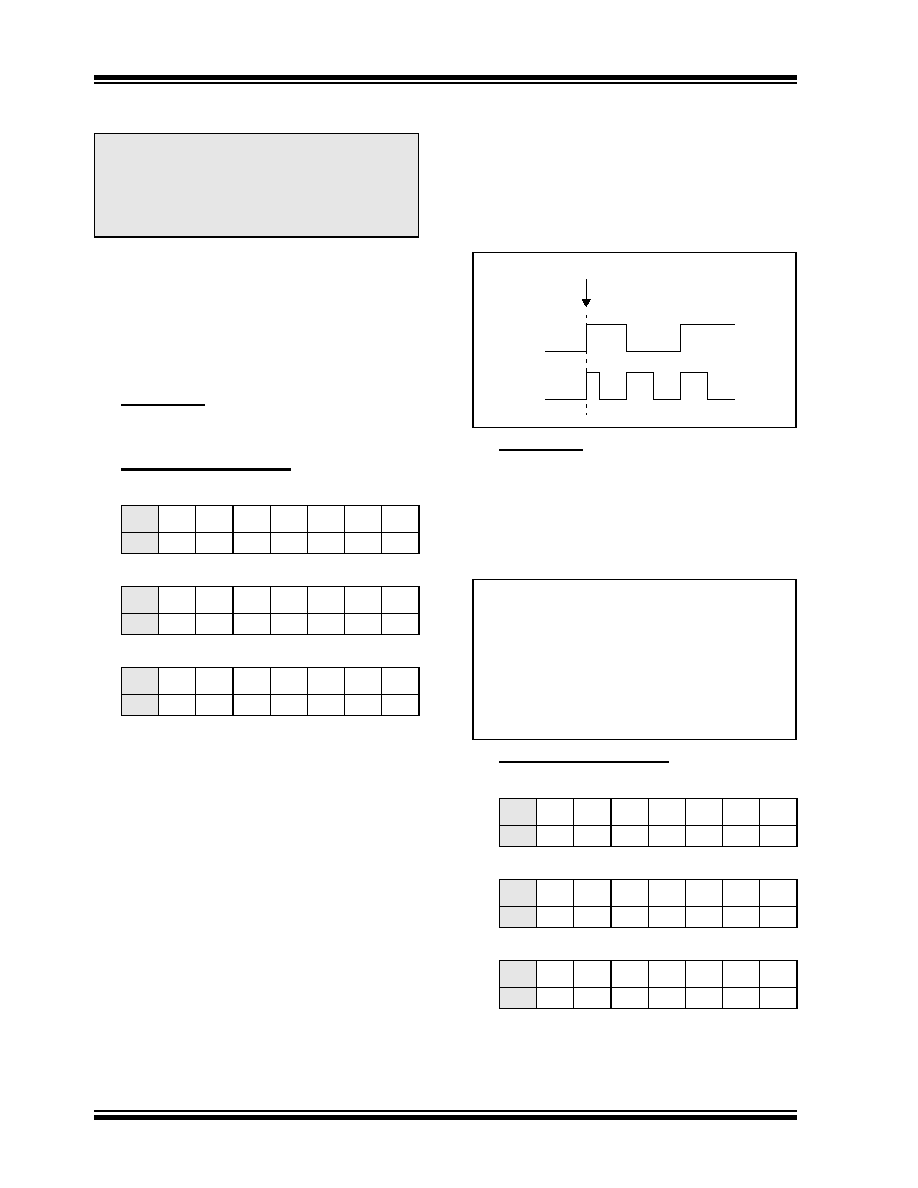- 您现在的位置:买卖IC网 > Sheet目录3873 > PIC16F884-I/ML (Microchip Technology)IC PIC MCU FLASH 4KX14 44QFN

PIC16F88X
DS80302F-page 4
2009 Microchip Technology Inc.
Silicon Errata Issues
1.
Module: Low-Voltage In-Circuit Serial
Programming (LVD)
If LVP (Low-Voltage Programming) mode is
enabled, programming the device using the VPP
pin while holding high or toggling the port pin RB3/
PGM during Program mode could disrupt the
programming sequence.
Work around
Pull down pin RB3/PGM using external circuitry
during programming of the device.
Affected Silicon Revisions
PIC16F882
PIC16F883/PIC16F884
PIC16F886/PIC16F887
2.
Module: MSSP (SPI Mode)
When the SPI is using Timer2/2 as the clock
source, a shorter than expected SCK pulse may
occur on the first bit of the transmitted/received
data (Figure 1).
FIGURE 1:
SCK PULSE VARIATION
USING TIMER2/2
Work around
To avoid producing the short pulse, turn off Timer2
and clear the TMR2 register, load the SSPBUF
with the data to transmit and then turn Timer2 back
on. Refer to Example 1 for sample code.
EXAMPLE 1:
AVOIDING THE INITIAL
SHORT SCK PULSE
Affected Silicon Revisions
PIC16F882
PIC16F883/PIC16F884
PIC16F886/PIC16F887
Note:
This document summarizes all silicon
errata issues from all revisions of silicon,
previous as well as current. Only the
issues indicated by the shaded column in
the following tables apply to the current
silicon revision (A0 or A2, as applicable).
A0
X
A0
X
A2
X
A0
X
A0
X
A2
X
SDO
SCK
Write SSPBUF
bit 0 = 1 bit 1 = 0
bit 2 = 1 . . . .
LOOP BTFSS SSPSTAT, BF
;Data received?
;(Xmit complete?)
GOTO
LOOP
;No
MOVF
SSPBUF, W
;W = SSPBUF
MOVWF
RXDATA
;Save in user RAM
MOVF
TXDATA, W
;W = TXDATA
BCF
T2CON, TMR2ON
;Timer2 off
CLRF
TMR2
;Clear Timer2
MOVWF
SSPBUF
;Xmit New data
BSF
T2CON, TMR2ON
;Timer2 on
发布紧急采购,3分钟左右您将得到回复。
相关PDF资料
PIC16CR77-I/P
IC PIC MCU 8KX14 40DIP
PIC18F45K20-I/MV
MCU 32KB FLASH 1536B RAM 40-UQFN
PIC16CR76T-I/SS
IC PIC MCU 8KX14 28SSOP
PIC18F13K50-I/P
IC PIC MCU FLASH 4KX16 20-PDIP
PIC16CR76T-I/SO
IC PIC MCU 8KX14 28SOIC
PIC18LF24K22-I/MV
IC PIC MCU 16KB FLASH 28UQFN
PIC18LF24K22-I/ML
IC PIC MCU 16KB FLASH 28QFN
PIC16CR76T-I/ML
IC PIC MCU 8KX14 28QFN
相关代理商/技术参数
PIC16F884-I/P
功能描述:8位微控制器 -MCU 7KB Flash 256 RAM 36 I/O RoHS:否 制造商:Silicon Labs 核心:8051 处理器系列:C8051F39x 数据总线宽度:8 bit 最大时钟频率:50 MHz 程序存储器大小:16 KB 数据 RAM 大小:1 KB 片上 ADC:Yes 工作电源电压:1.8 V to 3.6 V 工作温度范围:- 40 C to + 105 C 封装 / 箱体:QFN-20 安装风格:SMD/SMT
PIC16F884-I/PT
功能描述:8位微控制器 -MCU 7KB Flash 256 RAM 36 I/O RoHS:否 制造商:Silicon Labs 核心:8051 处理器系列:C8051F39x 数据总线宽度:8 bit 最大时钟频率:50 MHz 程序存储器大小:16 KB 数据 RAM 大小:1 KB 片上 ADC:Yes 工作电源电压:1.8 V to 3.6 V 工作温度范围:- 40 C to + 105 C 封装 / 箱体:QFN-20 安装风格:SMD/SMT
PIC16F884T-I/ML
功能描述:8位微控制器 -MCU 7KB Flash 256 RAM 36 I/O RoHS:否 制造商:Silicon Labs 核心:8051 处理器系列:C8051F39x 数据总线宽度:8 bit 最大时钟频率:50 MHz 程序存储器大小:16 KB 数据 RAM 大小:1 KB 片上 ADC:Yes 工作电源电压:1.8 V to 3.6 V 工作温度范围:- 40 C to + 105 C 封装 / 箱体:QFN-20 安装风格:SMD/SMT
PIC16F884T-I/PT
功能描述:8位微控制器 -MCU 7KB Flash 256 RAM 36 I/O RoHS:否 制造商:Silicon Labs 核心:8051 处理器系列:C8051F39x 数据总线宽度:8 bit 最大时钟频率:50 MHz 程序存储器大小:16 KB 数据 RAM 大小:1 KB 片上 ADC:Yes 工作电源电压:1.8 V to 3.6 V 工作温度范围:- 40 C to + 105 C 封装 / 箱体:QFN-20 安装风格:SMD/SMT
PIC16F886-E/ML
功能描述:8位微控制器 -MCU 14KB Flash 368 RAM 25 I/O RoHS:否 制造商:Silicon Labs 核心:8051 处理器系列:C8051F39x 数据总线宽度:8 bit 最大时钟频率:50 MHz 程序存储器大小:16 KB 数据 RAM 大小:1 KB 片上 ADC:Yes 工作电源电压:1.8 V to 3.6 V 工作温度范围:- 40 C to + 105 C 封装 / 箱体:QFN-20 安装风格:SMD/SMT
PIC16F886-E/SO
功能描述:8位微控制器 -MCU 14KB Flash 368 RAM 25 I/O RoHS:否 制造商:Silicon Labs 核心:8051 处理器系列:C8051F39x 数据总线宽度:8 bit 最大时钟频率:50 MHz 程序存储器大小:16 KB 数据 RAM 大小:1 KB 片上 ADC:Yes 工作电源电压:1.8 V to 3.6 V 工作温度范围:- 40 C to + 105 C 封装 / 箱体:QFN-20 安装风格:SMD/SMT
PIC16F886-E/SP
功能描述:8位微控制器 -MCU 14KB Flash 368 RAM 25 I/O RoHS:否 制造商:Silicon Labs 核心:8051 处理器系列:C8051F39x 数据总线宽度:8 bit 最大时钟频率:50 MHz 程序存储器大小:16 KB 数据 RAM 大小:1 KB 片上 ADC:Yes 工作电源电压:1.8 V to 3.6 V 工作温度范围:- 40 C to + 105 C 封装 / 箱体:QFN-20 安装风格:SMD/SMT
PIC16F886-E/SP
制造商:Microchip Technology Inc 功能描述:8-Bit Microcontroller IC